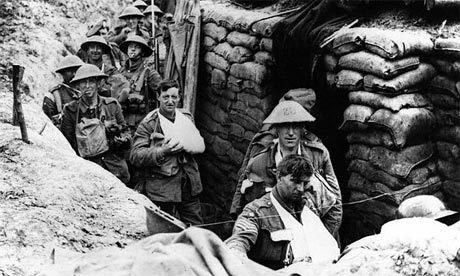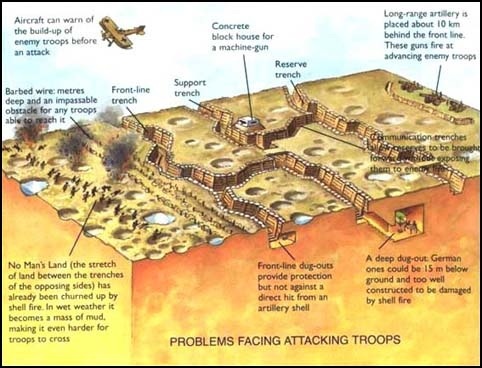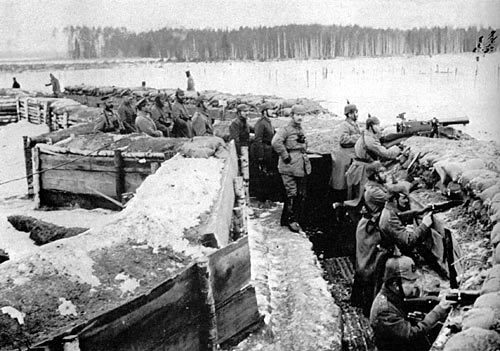Life in the Trenches Part 1
Life in the trenches has become one of the most enduring images of the First World War. Conditions in the trenches were beyond squalid. Death, appalling injury, disease and destruction surrounded the troops at every turn. The danger of a gas attack was omnipresent. Enemies whose only wish was to kill their inhabitants lived close by, sometimes as little as 100 feet away. Up to a third of all Allied casualties on the Western front were sustained within the trenches themselves. If the enemy didn't get you, disease was often not far behind.
Of course, not all of the soldiers served in the trenches. Behind the front line lay a great mass of stores, workshops, and headquarters, supply lines that were vital to keep the war effort going, training centers and other supporting infrastructure. In these rear areas would be found the majority of troops. Behind and to the sides of the infantry in the trenches could also be found the supporting forces of the artillery, their observers, the engineers, the machine gunners and the mortar operators.
Although trench warfare reached its most sophisticated development, and most extensive deployment during World War I, trenches were not an innovation of the Great War. Trench warfare had already been in use for at least two centuries, beginning with the Spanish Wars of Succession in the eighteenth century. They had also appeared in the American Civil War (1861-1865), the Second Anglo-Boer War (1899-1902) and the Russia-Japanese War (1904-1905).
There was a wide variation in the nature of the trenches used throughout the Western Front. In the Somme valley, for example, the chalky soil was prone to crumbling after rain, so the trench walls had to be faced with timber, sandbags or whatever material was available. In the muddy, low-lying lands of Flanders, it was not so much a case of digging down as building up: the men used sandbags and wood to manufacture their defenses and parapets. In some places in France, trenches ran through towns and villages, across railway lines and rivers, through industrial sites and coalmines. The men whose job it was to dig in were forced to invent and improvise to meet the various challenges presented by the terrain.
The vast lines of trenches were built to definite plans. Between the two combatants there was a no-man's land often fronted on either side by minefields. Behind the mines were barbed wire entanglements and sometimes even more mines. The front line would usually consist of a main fire trench facing the enemy. These were not always cut in a straight line, but followed the natural contours and features of the land. The lack of straight lines had another advantage: digging in sections, or bays, would limit damage to a particular section if a shell exploded in it. Moreover, should some of the enemy manage to infiltrate a bay, they might more easily be contained in that area. Extending from the front line were further trenches known as saps, which probed beyond the protective tangles of barbed wire and ended in no-man's land, manned by one or two soldiers engaged in listening and observing.
The trenches themselves were usually constructed with sandbags and timbers and contained a firing step and duckboards in the bottom to keep the soldier's feet above any rain water that had collected there. This was the ideal design. After incessant rain and frequent artillery fire had churned up the ground, however, the reality soon bore little resemblance to the original plans, particularly by the end of the war.
Behind the fire trench was another line of excavations called the support line. Here could be found dugouts cut into the trench wall with enough room to shelter perhaps three or four men or accommodate a signaling point or telephone position. Perhaps a platoon or company HQ could be found here. These trenches were expected to shelter troops for an extended period of time. To connect the areas at the rear to fire trenches and support lines, communication trenches would be dug. Along these lines would be ferried the equipment and supplies needed by the men at the front.
Deployment in the trenches followed a fairly strict cycle. An Allied battalion would typically serve a period of 70 days in the front line, which would be followed by another 70 days in support and a further 120-day period in the reserve lines. The length of time could vary depending on where the infantryman was and what was happening around him. These stints would then be followed by a 70-day period of rest, often all too short and sometimes interrupted by duties that would put the men back in the line of fire. Once a rotation was completed, the whole cycle would begin again. As for leave, when a soldier might expect to get away from the war altogether and perhaps even see his home and loved ones, two weeks might be granted during a year.




